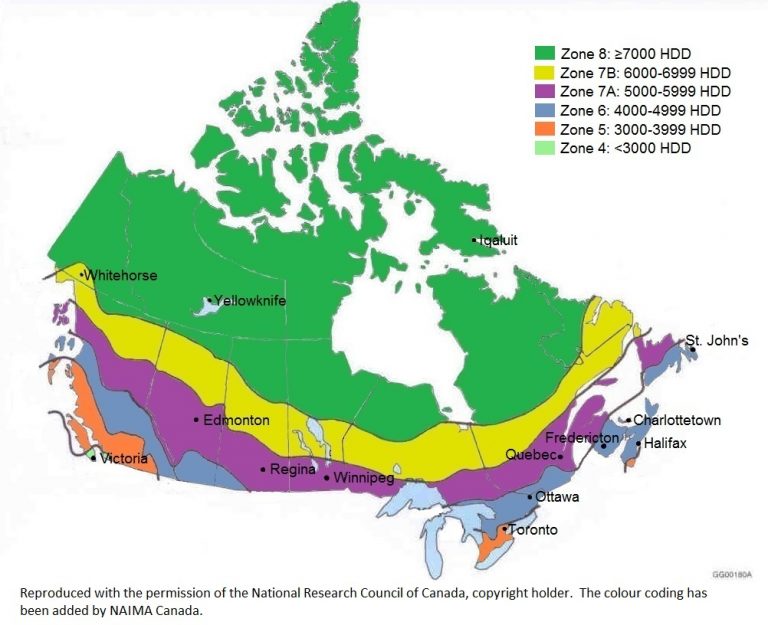Codes and Standards
Understanding Codes & Standards
In Canada, building codes are under the jurisdiction of the provinces and territories, with some chartered municipalities that have the power to mandate their own standards for their building by-laws. These jurisdictions are able to create their own codes, or they can adopt (or adapt) the national model codes, currently the 2015 National Building Code (NBC).
In December 2012, the Federal Government issued an amendment to the 2010 NBC to incorporate energy efficiency standards in housing (Section 9.36), and issued standards for energy efficiency in commercial, industrial, institutional, and large residential buildings [currently the 2015 National Energy Code of Canada for Buildings (NECB)]. For the first time, energy efficiency was introduced to the national model codes.
Looking for Thermal & Insulation Requirements?
If you’re looking for specific Canadian heating degree days, climate zones, and insulation code requirements for each city or region, then click the button below.
R (nominal) vs. R (effective) vs. U
Thermal resistance requirements in Canada are under the jurisdiction of the 13 provinces and territories, with a few chartered municipalities that adopt and enforce their own requirements (e.g., the Vancouver Building By-Law 10908). For this reason, there is a lot of variation in the requirements across Canada.
Some jurisdictions express minimum thermal resistance codes using nominal values, others using effective values. The use of nominal values is easier for the insulation industry, since the product packaging is marked with these values and they directly correlate with the amount of insulation required in a building assembly (e.g., above ground walls, roofs).
However, there is a move away from nominal to effective requirements in codes, with effective values representing the total thermal resistance of the whole assembly, not only insulation. Therefore, it is important that the insulation industry and its supply channels learn how to calculate the nominal insulation needed to meet those code requirements that are expressed in effective thermal resistance. There is no single conversion factor, since the effective values account for each feature of the assembly contributing to thermal resistance, and features vary from building structure to building structure.
R (Nominal): Thermal resistance value for insulation
R (Effective): Thermal resistance value of the whole building assembly
U: Thermal transmittance, usually used for total assembly element
Conversion tables have been developed by several government agencies. Three resources are:
- The Appendix tables to Section 9.36 in the NBC 2010 (not available as an online resource)
- The conversion tables issued by Natural Resources Canada to support the EnergyStar program
- The Canadian Wood Council Wall Thermal Design Calculator: Effective R-Value Calculator With Durability Analysis
Natural Resources Canada
Wall Thermal Design Calculator
The purpose of this online tool is to provide designers with climate zone-appropriate insulated wall assembly solutions that are easily comparable with national and provincial energy efficiency prescriptive provisions. Note that the CWC calculator at present applies only for wood frame walls.
Using these tables, the conversion from effective to nominal is completed as follows:
- Define the assembly features and sum up the R values for each of the features outside the cavity;
- Take that total away from the code requirement to find the difference that must be made up by the insulated cavity;
- Find the appropriate table for that cavity and look-up the nominal insulation needed in that particular cavity to make up the difference calculated in Step 2 (i.e., look-up the R (nominal) insulation needed to meet code for that assembly).
A note of caution: all code requirements can be expressed in either metric or imperial units. It is customary, but not obligatory, to use the letter R when the value is expressed in imperial units, and to use RSI when the value is expressed in metric units.
R: Imperial unit of measurement for thermal resistance
RSI: Metric unit of measurement for thermal resistance
All of the above applies to the way housing codes are written in Canada. Note that the 2015 National Energy Code for Buildings (NECB) expresses insulation requirements not as minimum thermal resistance (R effective), but as maximum thermal transmittance, designated by the letter U. U is simply the reciprocal of R (effective). It is customary, not obligatory, for U to be expressed in metric units.
Climate Zones and Heating Degree Days
The Canadian climate varies dramatically from the west to the east coast and the North Pole to the southern border, and this large variation can also be seen within many provinces. Many Canadian code bodies have chosen to take these variations into account, and in the case of energy efficiency codes, the thermal resistance requirements depend on the location’s climate. To address this issue, some provincial and territorial building codes set different thermal resistance requirements for different climate zones, which are usually determined by the number of heating degree days (HDD).
HDD are the number of degrees of temperature difference between a base temperature (usually 18°C) and the mean daytime outside temperature on any given day. For example, if the mean temperature for the day is 12°C, 6 HDD (18°C – 12°C = 6 HDD) will be recorded. The total number of HDD over the heating season indicates the relative severity of the winter for a specific location.
The national model codes have divided the country into six climate zones, as follows:
The climate zones are under the jurisdiction of the provincial governments, which may vary from those in the national model codes. When Section 9.36 or the 2015 NECB are adopted, the provincial or municipal governments may adopt or adapt the climate zones.

